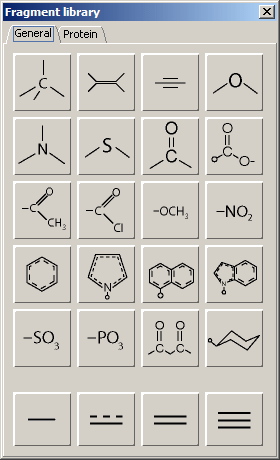Using the structure Builder
General Fragment Library
 |
To use the fragment library, first select/activate a fragment and click in the Structure Viewer to place the fragment or click on a hydrogen to attach it in place of the clicked hydrogen. Click on the fragment icon again to deselect. Bond order buttons are provided for convenient bond order modification. It is sufficient to activate the button with the desired bond order and click a bond in the structure display. When bond order is changed, valencies of the bonded atoms are also evaluated and hydrogen atoms are either added or deleted to balance the valencies correctly. Some fragments are non-symmetrical and have several non-equivalent attachment points. These are denoted by small circles in the fragment structures on the buttons. In order to cycle through the available attachment points, hold Alt key and repeatedly click the fragment button until the desired attachment point appears. Once the fragment is deactivated, the default attachment point is reset. |
Protein Fragment Library

|
Protein fragment palette is provided for structural modification of proteins and for building peptides. Each fragment is an amino acid monomer, rather than a complete structure of an individual amino acid. The fragments do not have a complete carboxyl group, but rather a carbonyl that remains after the peptide bond is formed. At this point, no force field checking is being performed to ensure correctness of the side chain orientation (especially when an amino acid is added to an existing protein). However, checking for steric clashes can be performed and geometry of the side chain corrected via manual rotation around any bond. |